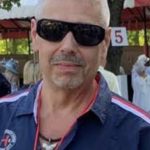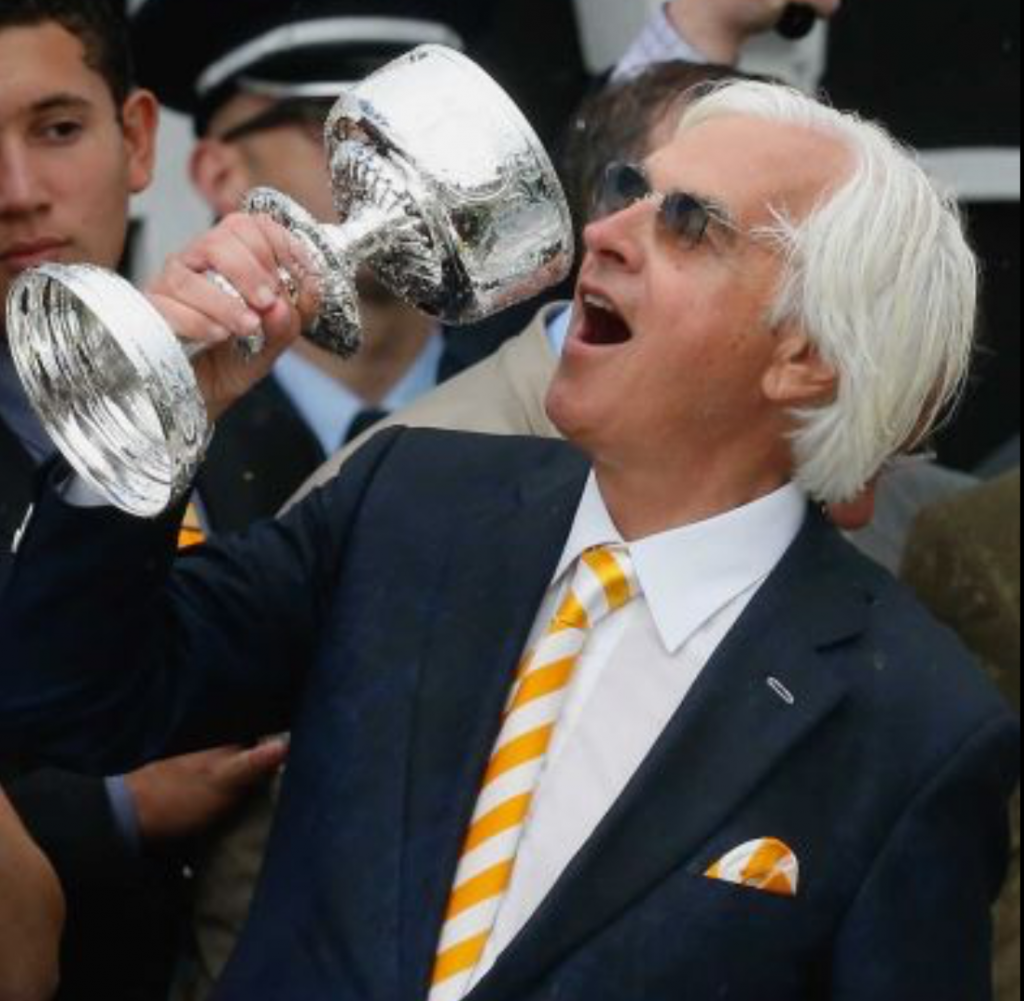
Past the Wire
Nobody Does It Better:
Past the Wire Films presents Nobody Does it Better, Bob Baffert
I always say, when you see the tip of an iceberg sticking out of the ocean, you already know what is underneath. You don’t have to see it: you know what is there. There is a whole lot more there than what you see on the surface. In the Sport of Kings, Bob Baffert is a good example of this. I had an opportunity to “talk horses” with Bob recently, as well as discuss various aspects of his amazing career. As remarkable as it may be, the past three years while Hall of Fame worthy indeed, it’s just the tip of the iceberg with Bob.
It’s early 2017, and the past three years would qualify as a look at the tip of the iceberg when it comes to Bob Baffert’s career. The last three Breeders’ Cup Classics with Arrogate, American Pharoah, and Bayern. All three for different owners and with different riders. In 2015 The Triple Crown, which had eluded the Sport of Kings for 37 years and felt more like a lifetime. It seemed so long it spurred talk of changing the timing of the three races required to win it, The Kentucky Derby, The Preakness, and The Belmont Stakes. He won the inaugural Pegasus World Cup, currently the world’s richest horse race with a purse of $12 million dollars. This is historic, even epic in our sport, but just the tip of the iceberg with Bob.
In the past three years, Bob has accomplished a lifetime of achievements at the highest level of our game, and it is just business as usual. There is so much more, and it has been going on a long time. Frankly, nobody does it better.
Before we get into that, let me say as a student of the game, a fan, a bettor, a former owner, and lover and rescuer of animals, it was truly a privilege to talk with Bob at length. He is as sharp as a razor when it comes to his craft, but that is obvious. What may not be as obvious, on a personal level Bob is a gracious, generous, and passionate gentleman. He’s quick to credit others like his assistant Jimmy Barnes, and his foreman Pasqual and everyone who works in his well-oiled machine of a barn. He knows it takes a team effort, and all the pieces must be in place, but he also knows how to run the show, and what it takes to be the best and lead the team. What you may or may not know, is Bob and his family love their horses. They are animal lovers. They get the best quality of care. Each and every one one of them, regardless of where they rank in the shed row. Of course, not every one of them bring that same twinkle to Bob’s eye as an American Pharoah, or an Arrogate, but the barn loves them all, and all are treated with the same level of care and attention. That is one of the elements of the long-term success the barn has had. If you don’t pay attention to all of them and give each one their chance to develop, you don’t continually turn out the type of horses Bob does. It just doesn’t happen.
I talked to Bob about how and why he got into training thoroughbreds. Back in the late 60’s and through the 70’s, Bubba Cascio was the king of quarter horse trainers. That title transitioned to D. Wayne Lukas and Bob was sort of known as the up and coming young guy. Bob wanted to be the best. That went for whatever he did. It’s why he stopped being a jockey and started training. When he knew he couldn’t be the best at being a jockey, he set his sights on training, knowing he could be the best.
“You must have a goal, a plan.”
We all know Wayne Lukas changed the thoroughbred game and how it is played on the big stage forever when he transitioned from quarter horses. Wayne off the plane they’d say as he shipped his regally bred horses all over the country to compete in the biggest stakes. Most trainers stayed at their home tracks for the most part. Not Wayne. He shipped anywhere there was a big purse or prestigious stake. That attracted powerful owners willing to buy expensive horses and entrust them to Lukas. Wayne won everything in sight and in addition to changing the landscape of how top barns competed, he became known for turning out former assistants that became top trainers. He also had a huge impact on Bob Baffert and was instrumental in where Bob is today.
When Wayne left quarter horses for thoroughbreds, Bob, the up and coming young trainer assumed the top spot, and was widely recognized as the best in that game. You don’t get to be the best at anything without two D’s, drive and dedication, and Bob had both. When he saw what Wayne Lukas could do in the thoroughbred world, he thought why can’t I do that. He knew it wouldn’t be easy. He remembered when he started in quarter horses how he looked up to both Bubba and Wayne and learned from watching them. He remembered how intimidation turned to determination and he was ready to do it again, and with every intent of being the best. This, despite by his own admission knowing little about training thoroughbreds. He was a horseman, and could train a quarter horse as good as anyone, but this was a different game.
By the time the late 80’s rolled around, Bob was living in California. He was working on the backstretch at Los Alamitos and had made the transition to thoroughbreds. He was a workaholic, student of the game, curious, and absorbed all he could. Now he was the young guy nobody thought knew anything who watched every move certain trainers made.
“Every day, 7 days a week I’d talk to guys like Charlie Whittingham, Laz Barrera, Ron McAnally, and Gary Jones. I’d watch and learn and absorb everything they did. I learned all their styles”
Bob learned all he could. His experience and horsemanship from the quarter horse industry was a huge help. Although this was a different game, and training thoroughbreds is different than training quarter horses, some fundamentals still applied.
“Now I had to keep horses happy, healthy, and sound racing distances from five and a half furlongs to a mile and a half, as opposed to 350-400 yards.”
By the time 1992 came around, which was only a little more than a year into Bob’s thoroughbred training career, he already somehow made his way to the big stage. Bob Baffert had his first Breeders’ Cup starter, and it was a horse he had purchased as a yearling for a partnership which included Mike Pegram, one of Bob’s biggest and earliest supporters. They are still together today. The horse was a fast, off the pace sprinter by Slewpy, who was a gorgeous colt by Seattle Slew. I saw Slewpy run many times. He was a looker, and won some races, but was one of those horses who always looked like he had more potential. Perhaps some of that potential was passed down to Thirty Slews and honed by Bob Baffert to have him at his peak for the 1992 Breeders’ Cup Sprint. Not many people knew who Bob Baffert was that day at Gulfstream Park, nor could they imagine they were witness to the launch of one of the greatest training careers in thoroughbred history.
I was at Gulfstream that day. Thirty Slews got up late at 19-1 to nail Meafara. It was an impressive victory. It also showed what was to come and what Bob was capable of. Buying a yearling, and developing a top thoroughbred, you needed a great eye, to know how to train, and to get a horse to their best and to peak for the big dance. Obviously, Bob learned a lot walking around the backside in Southern California.
Now Bob knew he could do it. He always knew it really, but now that he did it, it was validated. Success breeds success and Bob was full of
“hopes and dreams.”
He wanted to get back to The Breeders’ Cup, wanted more, wanted to win, and wanted to be the best. That has never changed. More importantly though, he knew what it took, and was willing to sacrifice and work for it.
“In all the years I have been training, I’ve never taken a vacation. I still owe Jill a honeymoon. We go to all these races to run horses, and its business, but we enjoy it and try and get the most out of it. We spent about 48 hours in London recently to accept the Longines award for Arrogate, and that was as close to a vacation as we came. We weren’t running anything. It goes 7 days a week, all year long.”
If the win in the first Breeders’ Cup race he saddled a horse in didn’t serve notice, then what happened in 1996 on the first Saturday in May should have. I always say; The Sport of Kings has the highest highs and lowest lows, and is not for the faint of heart. Bob has certainly experienced it all. In 1996, just 4 years after Thirty Slews took The Breeders’ Cup Sprint, Bob Baffert was in The Kentucky Derby. Bob got the Robert and Barbara Walter California homebred Cavonnier to Churchill Downs via a win in that year’s Santa Anita Derby. The horse was voted California Horse of the Year and champion 3- year old but fell about a whisker short of winning the roses. It was one of the closest Kentucky Derby finishes in history. He didn’t win, but it was obvious Bob came to run.
“The race was so close I thought we won. Our horse was on the inside and Lukas’ horse was on the far outside so it was hard to tell who won. I thought we did but wasn’t sure. It was as close as it gets.”
Back at that time Bob wanted nothing more than another shot at it. Who wouldn’t after coming so close? Things were different then though, and he was not sure if it would happen.
“I knew great trainers that went their whole careers without winning The Derby or getting a shot at it. I thought that was my shot maybe. I was determined to get back and to win, but you just know about all these great trainers who also wanted and worked for it. I just didn’t know.”
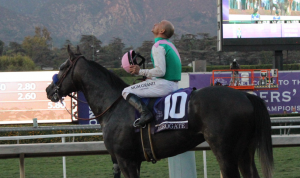
It wouldn’t be long before Bob Baffert did know. It took one year for Bob to get back, and this time he did win it with Silver Charm who also went on to take The Preakness and put Bob in position to win The Triple Crown. Silver Charm had the lead in the stretch of the 1997 Belmont Stakes but just couldn’t hold off the late surge of Touch Gold. Silver Charm couldn’t seal the deal on The Triple Crown, but he did get Bob his first win in The Dubai World Cup the next year as a 4-year old.
The highest highs and lowest lows in this game is no joke. The very next year, 1998, Bob was back at The Derby and in what by then could be called typical Bob Baffert fashion with a top contender. Real Quiet won The Kentucky Derby and The Preakness for Bob and his longtime supporter and friend Mike Pegram. Back to back years going for the elusive Triple Crown, one of the most difficult accomplishments in sports, is playing at the highest level. Bob didn’t win it in 1998, but came as close as you can without doing it when Real Quiet was nipped by Victory Gallop at the wire. Real Quiet opened a nice lead on the far turn and appeared to be loaded under Kent Desormeaux. He was clear throughout most of the stretch but Victory Gallop under Gary Stevens, (who was denied The Triple Crown along with Bob the prior year on Silver Charm) was relentless and kept coming. It was a closer photo than the one Cavonnier lost, and The Triple Crown was on the line.
When I asked Bob about his toughest beat, I was sure the answer would be Real Quiet in that Belmont. His answer was surprising.
“Cavonnier. It was my first Derby, and at that time I wasn’t sure I’d be back. I thought this might have been my shot, and to lose like that was just wow. I thought of all the trainers who never made it or never got back. It was a tough beat. By the time Real Quiet came along, I knew I’d be back. I felt good about getting another shot at it. That made it easier to take.”
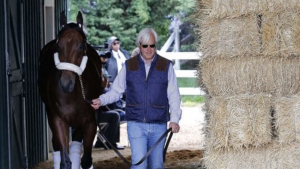
It may not have been as fast as with Silver Charm and Real Quiet, and certainly not as conventional, but Bob Baffert showed the world in 2002 there was more than one way to get to The Kentucky Derby. He privately purchased War Emblem, the winner of The Illinois Derby from Russell Reineman for The Thoroughbred Corp. They worked out a deal where Reineman stayed in for 10% of the horse. The Illinois Derby is not exactly known as a producer of Kentucky Derby winners, but Bob knew this horse was fast enough to do it. When he showed him to Prince Ahmed bin Salman the founder and principal partner in The Thoroughbred Corp., and a member of The Saudi Arabian royal family, Bob asked “what do you think of your new horse?” The Prince smiled and replied, “I love him.” War Emblem justified that love by winning the Kentucky Derby in wire to wire style using that speed that led Bob to purchase him. He also won The Preakness and made a habit of Bob Baffert going for The Triple Crown. The writing was on the wall, it was just a matter of time, but of course none of us knew it back then, except maybe Bob. War Emblem fell short in The Belmont after stumbling at the break, but you couldn’t take away his Derby win, or that he was one of the shrewdest private purchases ever.
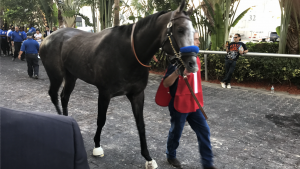
Bob married Jill while War Emblem was training for The Haskell. Prince Ahmed was going to come in for the race but told Bob he’d come in early for the wedding. Bob describes Prince Ahmed bin Salman as a good friend, a great and enthusiastic owner and kind man. Bob and Jill had War Emblem mementos for The Prince at their wedding, and were shocked and saddened when he died suddenly before coming in. Seeing the colors of The Thoroughbred Corp. was rough at the wedding, but Bob got The Prince his dream, a win in The Kentucky Derby. A win they thought would come earlier with a different horse.
“Staying on top in this business is hard if not harder than getting there. I have been fortunate to train for some great owners and people, but it is hard. You must be right and get the job done. I can’t afford to be wrong. When we ship and come to these races we expect to win. A lot goes into it. I’m very competitive, and we come to win.”
What was your most disappointing race?
“Point Given in The Kentucky Derby for The Thoroughbred Corp. He was a really good horse and I expected him to win. I still don’t know why he didn’t or what happened. It was a long walk back to the barn. The Prince took it well, but I was disappointed. Afterwards he galloped almost everywhere I ran him, but that day he just didn’t show up. He was definitely good enough to win it.”
Why do you think you are especially good winning major races with fresh horses or horses or layoffs? For example, training Arrogate up to The Breeders’ Cup Classic and then training him up to The Pegasus World Cup.
“With quarter horses, you train for two races, the prep where you want to run fast enough to qualify, but not too fast, and then improve in the next race. I knew if I could train that way with quarter horses, to get them to peak just at the right time, I could do it with thoroughbreds. Over time I became more confidant in getting a horse to be ready and even to peak off training.”
Speaking of Arrogate, where are you leaning or thinking about running him next?
“Originally, I was thinking about maybe The Pacific Classic, and ultimately The Breeders’ Cup Classic again. Maybe a race somewhere before that. He just came out of The Pegasus so good though. He’s just doing great and training great, I’m probably going to run him. Maybe The Santa Anita Handicap, or maybe Dubai. I’m sort of day to day on it. He’s just doing really good and I’ll probably go in one of those spots, rest him a little, and then look at those other two races.”
(It has since been announced Arrogate is likely headed for Dubai)
Speaking of Dubai, what changed if anything after your heart attack there?
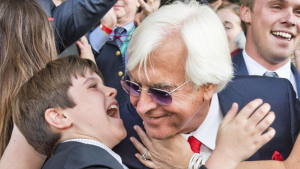
“I try to take better care of myself. Eating right and just taking better care. I was working so much I just let things go. There were warning signs too, I’d be on the phone and people would ask why are you out of breath? Jill noticed things also and asked me about them. Once I came up some stairs, and she asked me what happened, I was out of breath. About a week before it happened I had to run about 20 yards to grab a horse and I was exhausted. I said to myself I am out of shape. Then we flew over and I was lucky. If it happened on the plane it would have been curtains. That night I just didn’t feel well. I cancelled our dinner plans which I normally wouldn’t do, and I went to lay down and just felt worse and worse. I was lucky and received great care there, it scared Jill and our son, so I take better care of myself now. Around the barn though it is business as usual. I am lucky to have such great help, and I couldn’t do what I do without all of them. My whole barn. We laugh about retirement, Jill mentions it and then we’ll say no, I can’t retire, not now anyway. Not with horses like this. It’s fun to go to the barn in the morning.”
Is the 2017 Kentucky Derby winner in your barn?
“I like both Mastery and American Anthem as much as any of the other three-year olds I’ve seen. Both are top horses, and if they keep moving forward I like their chances. Both are good enough to get there and to win it I think.”
What about the horse you run today, Reach the World, is he the kind of horse who can step up late and make the gate in May? He never ran at two, so can he be the horse that breaks the Apollo curse?
“He’d really have to step up and run big. He’d have to win easy today, and I think he should. (Reach the World did win easy) He’d still have to keep going forward and improving. I don’t believe in the Apollo curse or any of those things. Eventually they all go down, just like The Triple Crown. They wanted to change the races, but they didn’t have to. It is tough to win, and everything must go right, but it wasn’t the races. It’s the same with the Apollo thing. Bodemeister could have done it. There was a sprinter in the race, and that made the pace really fast, with the new point system they keep the sprinters out of The Derby, and had Bodemeister gone just a little slower he would have been able to win and the Apollo thing would have been gone. Eventually it will be.”
All those years, and finally a Triple Crown winner, what was the stretch run like from your perspective?
“American Pharoah was a special horse. Like a lot of my good horses we knew it early on. Going in to the last race I felt good about it, I thought we are finally going to do it but until you do you never know. Everything has to go perfect. Afterwards I thought what next and expected a lull in the barn and then we got Arrogate. Those kinds of horses keep that twinkle in your eye.”
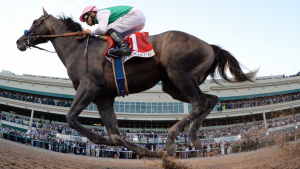
There is not much left for Bob Baffert to accomplish in The Sport of Kings. It might be hard to tell him that as speaking to him, you can feel his passion and excitement about the game. You just can’t compete consistently at that level without that competitiveness and drive. The longevity of his career and the races he’s won, for so many different owners, and with so many different types of horses is incredible.
Winning The Triple Crown with American Pharoah, the last three Breeders’ Cup Classics, The Pegasus World Cup, really is just the tip of the iceberg. Bob has started over 12 thousand thoroughbreds since he entered the sport. He’s won with 2724 of them. He has won 14 Breeders’ Cup races, with 12 seconds. He has 12 Triple Crown races notched on his belt, along with 7 seconds. He’s been a gracious winner, and a gracious runner up.
His horses have earned his owners over $254 million dollars, and still counting. He has won The Eclipse Award as Best Trainer in 1997, 1998, 1999, and again in 2015. He was put into racing’s Hall of Fame in 2009. He is just as enthusiastic today as he was walking the backstretch at Los Alamitos in the late 80’s only now they know who he is, and people are learning from him. That’s good for them. Nobody does it better.


